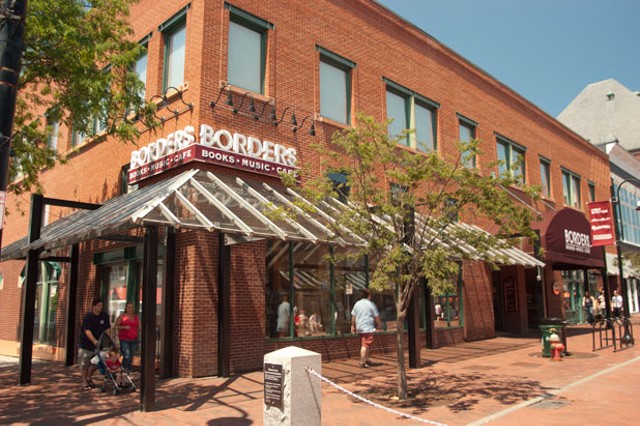Published July 6, 2011 at 7:38 a.m.
Borders Books in downtown Burlington is expected to shut its doors within the next few months. If no similar emporium emerges to replace it, “something essential” will be lost, warns a longtime former bookseller.
Gary Chassman, owner for many years of the last independent new-book store on the Church Street Marketplace, describes such an enterprise as “the lifeblood of a community.” A well-stocked bookshop with “color and personality” and a sure feel for local culture serves as an “intellectual and social center,” says the founder of Chassman & Bem, which catered to Burlington bibliophiles from 1985 until 1998.
Paul Bruhn shares that appreciation. “I can’t imagine downtown without a good bookstore,” says the director of Preservation Trust of Vermont, whose office overlooks the Marketplace. Bruhn suggests the trust would be willing to help finance a locally owned successor to the bankrupt Borders chain, which announced the closure of its Burlington outlet last month.
First, though, the city’s Community and Economic Development Office and the trust would have to find funding for a projected $10,000 study of the potential viability of a physical space that sells print volumes in the age of Amazon and e-books. “Opening a new bookstore in 2011 is not commonplace,” observes Marketplace director Ron Redmond. Failure is certain, he predicts, “if it’s based on a 20th-century model.”
Bruhn agrees. “To make something like this work these days, it needs to be a community-sponsored effort,” he says, rather than a purely private venture. “There needs to be a mix of charitable capital, community investment and entrepreneurship.”
Bruhn points to Claire’s Restaurant & Bar in Hardwick as a possible template. The Preservation Trust put seed money into this now three-year-old fixture of the Hardwick food scene. It also drew start-up support from 50 locals who each bought $1000 subscriptions.
“We adapted the CSA [community-supported agriculture] model to a restaurant,” says Linda Ramsdell, a partner in Claire’s. Subscribers are entitled to a $25 discount each time they eat at the restaurant during a four-year period, explains Ramsdell, who’s also the proprietor of the Galaxy Bookshop just down the street in Hardwick.
While upbeat about the feasibility of an indie bookstore in Burlington, Ramsdell cautions it’s no surefire proposition. “There’s a whole lot of questions to think about, especially cash flow,” she says, recalling that Claire’s initially struggled to meet monthly expenses even with its philanthropic backing. A bookstore may find it much tougher to stay in business, Ramsdell adds. While there’s no virtual way to eat out, millions of readers who used to leave home to buy books at indies or chain stores now order via their computers or, increasingly, download directly to their Kindles, Nooks or smartphones.
Acknowledging that Galaxy could be trampled in the e-reader stampede, Ramsdell says that, if her 28-year-old store does survive, “it will be through my stubborn determination and the people who support this community asset with their dollars.” The big unknown, she adds, “is whether there’s enough of those people.”
There just may be in an area like Burlington, with its academic institutions as well as a civic culture that values independence and local authenticity. Burlington also has a history of vibrant and varied retail activity downtown.
“People still need places to come to physically and engage in real-time, face-to-face discussions with one another and with authors,” Ramsdell insists. “People do have to look up from their screens at some point.”
Nationally, the number of independent bookstores appears to have stabilized following decades of decimation. Barnes & Noble and Borders had squeezed hundreds of indies into insolvency long before Amazon and e-readers came along with their powerful pincers. Chassman says his Church Street shop took a painful hit when Barnes & Noble opened its superstore on South Burlington’s Dorset Street in the mid-’90s, although Chassman & Bem’s ultimate demise, he claims, was a result of poor management on the part of a subsequent owner.
Resentment toward bookstore conglomerates may seem quaint, if not altogether irrelevant, in 2011. “It’s not so much chains versus locals these days but online versus bricks and mortar,” notes Chris Morrow, owner of Northshire Bookstore in Manchester Center. “Every bookstore in the country is under threat now from e-books.”
Claire Benedict, co-owner of Bear Pond Books in Montpelier, affirms, “It’s a precarious time for all of us.” With 20 percent of American adults having bought e-readers or tablet computers such as the iPad, “e-books are chipping and chipping away at what we offer,” Benedict laments. “If only a few of our customers shift each month to e-books…” she says, letting her listener reach the obvious conclusion.
Bear Pond, Northshire and Galaxy, along with the Flying Pig Bookstore in Shelburne, have all adopted similar strategies to stay in business. Each puts emphasis on personal service, which, Benedict suggests, indies can provide much more responsively than can chains or “stores” with no physical address.
Attentiveness to buyers and browsers involves hiring knowledgeable workers, says Flying Pig co-owner Josie Leavitt. “Any good independent’s staff can talk intelligently about any book in any section,” she remarks, drawing a contrast with Amazon, “where you really can’t trust the reviews because a lot of them are written by the author’s mother.”
Diversification is another key to keeping alive. “You’ve got to be flexible and sell products other than books,” Bear Pond’s Benedict says. “You’re not going to make it if you go on doing what you did five years ago.”
Ramsdell in Hardwick ruefully accepts that a “bookstore” must now offer puzzles, games and a variety of gifty tchotchkes. “I resisted that for a long time, but there’s really no other way,” she says.
Northshire goes further, selling Vermont-made children’s clothing as well as the same sort of nonbook items that almost all independents now carry. Music, however, no longer offers a prospect of salvation in the era of iTunes. “We just slimmed down our CD section last week,” Northshire’s Morrow reports.
All the local stores have bulked up their children’s sections. Flying Pig’s Leavitt explains why: “People will always buy books for their kids — even when money is tight.” Besides, picture books don’t have kid appeal in e-reader form.
Some grown-ups have soured on the electronic-book experience. Marketplace director Redmond, for example, says he’s ready to give away his Kindle “because I just don’t like reading the damn thing.” He admits in a phone interview that he “might be a Luddite, but I’m talking to you on a PDA.”
Despite all the looming hazards, the departure of Borders will present “a real opportunity for a new independent,” predicts Chassman, who now runs a consulting firm for aspiring authors. But why go through the fraught process of lining up investors and finding a prime location when a locally owned bookstore already exists on the Church Street Marketplace?
Keith Terwillegar, who opened Crow Bookshop 16 years ago on the top block of Church Street, is bemused by all the talk of the need to seed a replacement for Borders. “I see the Free Press and WCAX doing stories about how there’s room for an alternative to Borders downtown, and I’m thinking, Huh?” Terwillegar recounts.
Bruhn and others involved in the nascent planning for an indie start-up might be forgiven, however, for overlooking Crow. The store’s inventory consists almost entirely of used books. Its low-key exterior, a couple of doors up from three long-vacant storefronts, doesn’t necessarily attract newcomers to the place.
Crow likewise lacks community connections, other than with its regular browsers. Terwillegar notes it hasn’t hosted an author’s reading for years. There’s only one place to sit in its 1800 square feet, and nowhere to get the now-requisite espresso. Even the store’s website makes a modest impression.
The shop has survived, its owner says, partly because “our rent is very reasonable by Church Street standards.” The landlord who has cut Crow a deal all these years “appreciates what we’re trying to do.”
Terwillegar does recognize that he’ll be prettily positioned once Borders leaves. He says he’s planning to double or triple the number of new books Crow sells and would consider a physical expansion, as well. The second floor of 14 Church Street has remained unrenovated since it was damaged by a fire 20 years ago. Making it book-ready entails a financial commitment that Terwillegar says he’s been unable to make in the past but would now seriously entertain.
“I’m open to all ideas,” he declares, when asked about Bruhn’s proposal to have locals buy shares or subscriptions in a bookshop. “But to me,” Terwillegar adds, “the best business plan is to sell stuff that people want to buy. Developing that idea would be my first choice.”
Lurking in the background, meanwhile, is the long-shot chance that Borders might not close, after all.
Jeff Nick, co-owner of J.L. Davis Commercial and Industrial Real Estate, says he has received no notice of when Borders will leave the Church and Cherry Street corner location that his company owns. Nick says he still expects Borders to close some time this year, but points out that the chain is now considering an initial takeover bid from an Arizona-based private-equity firm. “Maybe they’ll buy Borders and decide to keep this store open,” Nick muses. “I don’t think that’s likely, but I really don’t know.”
"Top" Treatment
Will a million-dollar makeover finally cure what has long ailed the top block of the Church Street Marketplace?
The answer could emerge some time in 2013 if Marketplace director Ron Redmond proves accurate in his forecast for the completion of a federally funded redesign. Thanks to the intercession of that nonpareil bringer of bacon, Sen. Patrick Leahy, Burlington recently received $974,000 in Federal Highway Administration funds for a revamp of the underperforming block between Cherry and Pearl streets. Work is also scheduled to begin soon on a separate project intended to make Pearl Street, in the vicinity of the Marketplace, safer for walkers and bicyclists.
Chronic vacancies have plagued the northernmost section of the pedestrian shopping mall that sees its other empty storefronts snapped up, even though their occupants pay some of the heftiest commercial rents in Vermont.
Planners attribute the relative dormancy of the top block to a variety of factors.
Lack of “wraparound retail activity” is considered a big one. Unlike Main Street at the Marketplace’s southern end, the portions of Pearl Street nearest to Church Street are dominated by institutions: the Unitarian Church, the federal building and the former site of the Community College of Vermont. The top block is also proximate to a few social-service agencies, such as the Spectrum Youth & Family Services emergency youth center, some of whose clients occasionally congregate near Borders and are believed by retailers to scare off skittish shoppers. Finally, there’s a microclimate unique to the northern corner of the Marketplace that features wicked wintertime winds whipping off the lake and early shade cast by the Masonic Temple at 5 Church Street.
It’s long been assumed that an infrastructure attraction is needed near Pearl Street to lure pedestrians up from the Marketplace’s busy midsection. A fountain with a wading pool was built in 1994 for that purpose. But it’s now generally acknowledged that its puny spurts don’t impress many visitors, and it lacks places to sit and contemplate the dribblings.
Preliminary designs drawn up by Middlebury-based LandWorks pump up the fountain concept while adding jazzy seating areas. The landscape architecture firm, which designed Overlook Park on Spear Street in South Burlington, has been given a portion of the highway funding to conjure possibilities that “spur conversation among stakeholders,” Redmond says.
LandWorks principal David Raphael says he’s basing the initial sketches on an informal study of pedestrian movement on the top block. “We’ve looked at where people come from, as well as the climate issues and the generators, such as retail and restaurants that draw them to parts of Church Street,” Raphael explains.
“Something for kids is the key piece” for the top block, he says. “If you get the kids, you get the families.”
Raphael favors installing a “pop jet fountain” of the sort he encountered in a park in Santa Monica, Calif. “My 4-year-old and 6-year-old grandchildren played in it for a solid hour,” he says of that fountain, which shoots water in vertical streams. A pop jet has also been added to the Boulder, Colo., pedestrian mall, which closely resembles Burlington’s.
An alternative idea is a fountain that replicates the Lake Champlain watershed, Raphael says. He also wants Burlington officials to consider a “Times Square-ian display” of news headlines and artworks that would zip across the backs of seats added in the center of the walkway.
“There needs to be a little more there there,” Raphael comments in regard to the top block and in homage to Gertrude Stein, who said something similar about Oakland, Calif.
The top block does have its strengths, Redmond argues. Urban Outfitters is “a big draw,” he says. And the expected loss of Borders shouldn’t prove a problem, he adds. Realtor Jeff Nick says he has a retail tenant, whom he won’t identify, who’s ready to occupy both floors of 29 Church Street as soon as the bookstore moves out.
More By This Author
About the Artist

Matthew Thorsen
Bio:
Matthew Thorsen was a photographer for Seven Days 1995-2018. Read all about his life and work here.
Matthew Thorsen was a photographer for Seven Days 1995-2018. Read all about his life and work here.
Speaking of Business,
-

Vermont to Open $20 Million Business Flood Relief Fund
Jul 27, 2023 -

Video: Following Seven Days' Paper Trail to Québec
Jun 21, 2023 -

Rochester Grocery Store to Close, Leaving Residents in the Lurch
Apr 24, 2023 -

Video: Saying Goodbye to Burlington’s Penny Cluse Café
Nov 17, 2022 -

Essay: Natalie Miller Riffs on How Her Nightclub Survived the Pandemic
Sep 14, 2022 - More »
Comments
Comments are closed.
From 2014-2020, Seven Days allowed readers to comment on all stories posted on our website. While we've appreciated the suggestions and insights, right now Seven Days is prioritizing our core mission — producing high-quality, responsible local journalism — over moderating online debates between readers.
To criticize, correct or praise our reporting, please send us a letter to the editor or send us a tip. We’ll check it out and report the results.
Online comments may return when we have better tech tools for managing them. Thanks for reading.
















































